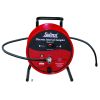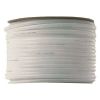Solinst Model 425 Discrete Interval Sampler
Features
- Avoids purging and disposal of purged water
- Obtain high quality discrete zone samples
- Profile wells or open bodies of water
- Free ground shipping
- Expedited repair and warranty service
- Lifetime technical support
- More
Overview
The Solinst Model 425 Discrete Interval Sampler is a stainless steel groundwater sampler designed for use with LDPE tubing mounted on a reel. The reel has a pressure attachment for a high-pressure hand pump and a pressure/vent switch, which is used to apply and release the pressure on the sampler. A sample release device is included with each standard Discrete Interval Sampler.
Applications
Discrete interval sampling is ideal for obtaining truly representative groundwater samples from below floating product layers, or for obtaining samples of the product itself. The discrete interval sampler can also be used to profile open bodies of water and boreholes, and to collect samples from distinct levels or points of inflow. The Discrete Interval Sampler is a passive sampler that is pressurized when lowered and upon retrieval to prevent water from mixing at different levels. Designed to give zero purge samples.
Models
Solinst also offers the Model 425-D Deep Sampling Discrete Interval Sampler for obtaining samples from submerged depths as much as 1200m (4000 ft). Biodegradable disposable PVC bailers and stainless steel Point Source Bailers are also available.
- (1) Model 425 Discrete Interval Sampler
- (1) Sample Release Device
In The News
Monitoring OAE Efforts in Halifax: Fighting Climate Change with Emerging mCDR Strategies
Marine carbon dioxide (CO 2 ) removal (mCDR) is an emerging strategy that aims to fight climate change by taking advantage of the carbon capture potential of our oceans. There are multiple types of mCDR approaches being evaluated globally, one of which is ocean alkalinity enhancement (OAE). According to NOAA , OAE aims to increase the pH of water by either adding alkaline material to ocean surface waters or by removing acid from seawater. Due to the change in acidity, the chemistry of seawater changes, making it capable of absorbing greater volumes of CO 2 .
Read MoreLake Erie Volunteer Science Network: Building Trust in Citizen Science Programs
Citizen science programs have popped up across the United States, focusing on connecting local communities with nearby water resources and building a trustworthy data pool over the sampling period. While commonly utilized as a means of ensuring that large watersheds or lake regions are adequately sampled, the credibility and success of such programs have been called into question. [caption id="attachment_38996" align="alignnone" width="940"] HRWC volunteers measure stream velocity across a subsection of Woods Creek, a tributary of the Huron River near Belleville, Michigan. Stream velocity measurements can be combined with water level measurements to calculate stream flow and chemical parameter loads.
Read MoreMonitoring Lake Erie’s Eastern Basin: Building Long-Term Data and Real-Time Public Solutions
In the eastern basin of Lake Erie, off the coast of Dunkirk, New York, a data buoy collects valuable water quality, weather, and wave data that inform residents and regulatory groups of conditions on the water. Since 2011, Buffalo State University’s Great Lakes Center has maintained and operated the Dunkirk buoy with funding from the Great Lakes Observing System (GLOS) and field support from the NYSDEC Lake Erie Fisheries Research Unit. [caption id="attachment_38976" align="aligncenter" width="940"] The Dunkirk Buoy viewed from the research vessel after being deployed in early spring.
Read More






















